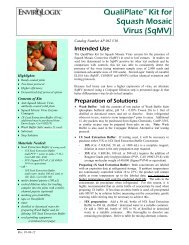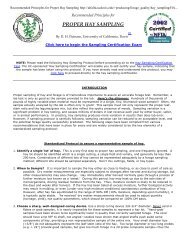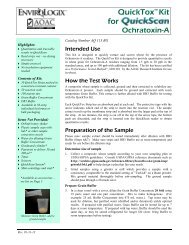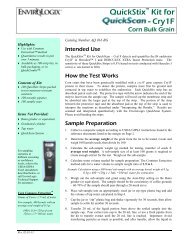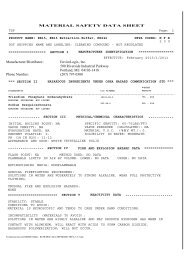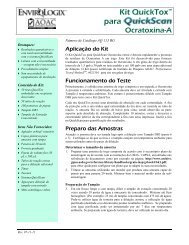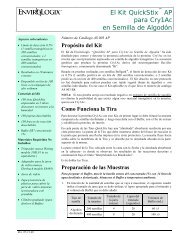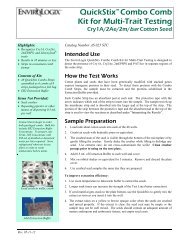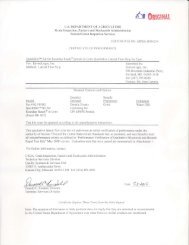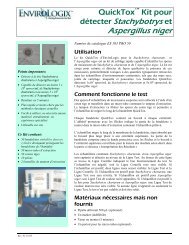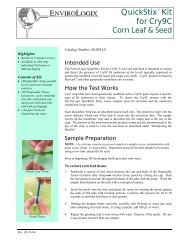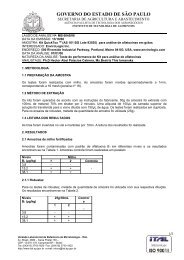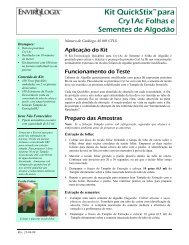Product Insert - EnviroLogix
Product Insert - EnviroLogix
Product Insert - EnviroLogix
Create successful ePaper yourself
Turn your PDF publications into a flip-book with our unique Google optimized e-Paper software.
Highlights:<br />
Detection of ten different<br />
Trichothecene toxins: Satratoxin<br />
G & H, Isosatratoxin F, Roridin<br />
A, E, H & L-2, Verrucarol, and<br />
Verrucarin A & J<br />
Results in one hour—faster and<br />
more cost effective than current<br />
methods<br />
Extremely sensitive—rivals the<br />
sensitivity of current HPLC<br />
protocols<br />
Contents of Kit:<br />
12 strips of 8 antibody-coated wells<br />
each, in plate frame<br />
1 vial of 900 ppb Roridin A Stock<br />
Solution in 50% MeOH<br />
1 bottle of Satratoxin Enzyme<br />
Conjugate<br />
1 bottle of Substrate<br />
1 bottle of Stop Solution<br />
1 packet of PBS salts (Sigma<br />
Chemical, Cat. # P-3813)<br />
Precision<br />
Rev. 04-28-11<br />
Recovery<br />
(%CV)<br />
OD<br />
(%CV)<br />
Intra-Assay n=7<br />
Control 1 21.5% 5.1%<br />
Control 2 8.5% 4.1%<br />
Inter-Assay n=10<br />
Control 1 18.7% n/a<br />
Control 2 16.6% n/a<br />
Catalog Number EP 100<br />
QuantiTox Kit<br />
for Trichothecenes<br />
Intended Use<br />
The <strong>EnviroLogix</strong> QuantiTox Kit for Trichothecenes is a 96-well plate kit<br />
designed for the quantitative laboratory detection of Tricothecenes, including<br />
Roridin A, E, H and L-2, Satratoxin G and H, Isosatratoxin F, Verrucarin A<br />
and J, and Verrucarol in bulk samples. The assay’s quantitation range is from<br />
0.2 to 18.0 parts per billion (ppb) of Roridin A in the sample extract.<br />
How the Test Works<br />
This Kit is a competitive Enzyme-Linked ImmunoSorbent Assay (ELISA). In<br />
the test, tricothecenes in the sample compete with enzyme (horseradish<br />
peroxidase)-labeled satratoxin for a limited number of antibody binding sites<br />
on the inside surface of the test wells.<br />
After a simple wash step, the outcome of the competition is visualized with a<br />
color development step. As with all competitive immunoassays, sample<br />
concentration is inversely proportional to color development.<br />
Darker color = Lower concentration<br />
Lighter color = Higher concentration<br />
Limit of Detection<br />
The Limit of Detection (LOD) of this kit is 0.14 ppb. The LOD was<br />
determined by interpolation at 92.3% B0* from a standard curve. 92.3% B0<br />
was determined to be 3 standard deviations from the mean of a population of<br />
negative bulk samples.<br />
*100% B 0 equals the maximum amount of Satratoxin Enzyme Conjugate that is bound<br />
by the antibody in the absence of any trichothecenes in the sample (i.e. negative<br />
control). % B 0 = (OD of Sample or Calibrator/OD of Negative Control) x 100.<br />
Precision<br />
Satratoxin H-fortified control solutions were repetitively analyzed both within<br />
a single assay, and in different assays on different days. The data is expressed<br />
as %CV for both the recovered concentration and for absorbance (OD).<br />
Fortification and Recovery<br />
Six bulk samples were fortified with Roridin to a concentration of 2.0 ppb.<br />
The average recovery was 103.6%, with a CV of 24.5%.<br />
Cross-Reactivity<br />
This Kit does not distinguish between various macrocyclic trichothecenes, but<br />
detects their presence to differing degrees. The table (page 2, left margin)<br />
shows the concentrations of cross-reacting mycotoxins that are approximately<br />
equivalent to the three Roridin A (RA) Calibrators run in the kit. Concentrations<br />
are in ppb.
Cross-Reactivity<br />
Mycotoxin 0.2 ppb<br />
RA<br />
Calib.<br />
Rev. 04-28-11<br />
2.0 ppb<br />
RA<br />
Calib.<br />
18 ppb<br />
RA<br />
Calib.<br />
Satratoxin G 0.338 1.32 4.45<br />
Satratoxin H 0.086 1.07 9.48<br />
Isosatratoxin<br />
F<br />
0.043 0.266 1.199<br />
Verrucarol 16.21 561.5 9241.5<br />
Verrucarin A 1.11 13.32 107.6<br />
Verrucarin J 1.11 21.94 161.70<br />
Roridin L-2 5.68 68.44 457.75<br />
Roridin E 0.025 0.500 5.209<br />
Roridin H 0.16 5.94 75.64<br />
QuantiTox Kit for Trichothecenes<br />
Page 2 of 8<br />
The toxins listed below were found to be non-reactive in the Trichothecenes<br />
plate kit when run at a level of 1000 ppb (roughly 50 times higher than the<br />
highest calibrator).<br />
Aflatoxin B1 Fumonisin B1<br />
Citrinin Gliotoxin<br />
Cyclosporin Griseofulvin<br />
Cytochalasin E Ochratoxin A<br />
Deoxynivalenol Patulin<br />
Emodin T-2<br />
Precautions and Notes<br />
IMPORTANT: Roridin A is highly toxic. All liquids should be disposed<br />
of in a plastic container containing at least 10% household bleach. All<br />
contaminated glassware should soak for 1 hour in a 30% bleach solution<br />
before being washed. Wear gloves and other protective apparel at all times.<br />
If liquid comes into contact with skin, wash immediately with water.<br />
Store all Plate Kit components at 4°C to 8°C (39°F to 46°F) when not in use.<br />
Do not expose Plate Kit components to temperatures greater than 37°C<br />
(99°F) or less than 2°C (36°F).<br />
Allow all reagents to reach ambient temperature (18°C to 27°C or 64°F to<br />
81°F) before use.<br />
Do not use kit components after the expiration date.<br />
Do not use reagents or test well strips from one Plate Kit with reagents or<br />
test well strips from a different Plate Kit.<br />
Do not expose Substrate to sunlight during pipetting or while incubating in<br />
the test wells.<br />
As with all tests, it is recommended that results be confirmed by an<br />
alternate method when necessary.<br />
The assay has been optimized to be used with the protocol provided in the<br />
kit. Deviation from this protocol may invalidate the results of the test.<br />
Observe any applicable regulations when disposing of samples and kit<br />
reagents.<br />
Items Not Provided<br />
disposable tip, adjustable air-displacement pipette to deliver 100 µL -<br />
1000 µL (optional)<br />
positive displacement pipette to deliver 10, 20 and 100 µL (Microman TM<br />
or equivalent)<br />
twelve-channel pipette to deliver 50 µL and 100 µL (optional)<br />
marking pen (indelible)<br />
tape or Parafilm<br />
timer<br />
microtiter plate reader or strip reader<br />
microtiter plate washer (optional)<br />
racked dilution tubes for loading samples into the plate with a 12-channel<br />
pipette (optional)<br />
distilled or deionized water<br />
orbital plate shaker (optional)<br />
NOTE: It is recommended that all samples be extracted with the PBS<br />
provided in the kit. Contact <strong>EnviroLogix</strong> Tech Support if sample<br />
extracts are in a different solution or solvent.
Qualitative Use of This Kit<br />
To use this kit in a qualitative format,<br />
prepare only the 0.2 ppb Roridin A<br />
calibrator. Run samples with both the<br />
negative calibrator (PBS) and the 0.2<br />
ppb Roridin A calibrator in duplicate.<br />
Rev. 04-28-11<br />
Remove unneeded strips<br />
Preparation of Solutions<br />
PBS Extraction/Dilution Buffer<br />
QuantiTox Kit for Trichothecenes<br />
Page 3 of 8<br />
Make up 1.0 liter of phosphate buffered saline (PBS), pH 7.4 ± 0.05. Add the<br />
PBS salt packet to 1.0 liter of distilled or deionized water. Stir until all of the<br />
salts have dissolved. The Buffer should be stored refrigerated when not<br />
being used to prevent bacterial contamination. Warm to room temperature<br />
prior to use.<br />
Roridin A Calibrators in PBS Extraction/Dilution Buffer<br />
Working levels of Roridin A must be made daily in PBS. A positivedisplacement<br />
pipette must be used to dispense the Roridin A stock solution.<br />
At the end of the day, any unused calibrators should be disposed of by adding<br />
to a 10% household bleach solution.<br />
1. Using a positive-displacement pipette, dilute the 900 ppb Roridin A Stock<br />
Solution to 18.0 ppb, 2.0 ppb and 0.2 ppb in PBS in a glass test tube, as<br />
described below.<br />
18.0 ppb Roridin A Calibrator = 20 µL of 900 ppb Stock Solution<br />
into 980 µL PBS<br />
2.0 ppb Roridin A Calibrator = 100 µL of 18 ppb Calibrator into<br />
800 µL PBS<br />
0.2 ppb Roridin A Calibrator = 10 µL of 18 ppb Calibrator into 890<br />
µL PBS<br />
Negative Calibrator: use an aliquot of the PBS stock<br />
Sample Extraction and Preparation<br />
Refer to Appendix A, page 8.<br />
How to Run the Assay<br />
Read all of these instructions before running the kit.<br />
Allow all reagents to reach room temperature prior to use. Do not<br />
remove strips from foil pouch until they have warmed up).<br />
If more than three strips are to be run at one time, the loading time will<br />
most likely exceed 10 minutes, and the use of a multi-channel pipette is<br />
recommended in steps 3, 4, 7 and 9.<br />
If three or fewer strips are to be run, use a disposable-tip, airdisplacement<br />
pipette and a clean pipette tip to add each Calibrator and<br />
sample extract to the wells. Conjugate, Substrate, and Stop Solution may<br />
be added in the same manner; alternatively, use a repeating pipette with a<br />
disposable tip for these three reagents.<br />
If fewer than all twelve strips are used, reseal the remaining strips and the<br />
desiccant in the foil pouch and refrigerate.<br />
Use the well identification markings on the plate frame as a guide when<br />
adding the samples and reagents. For a quantitative assay, the Negative<br />
Calibrator (NC) and three Roridan A Calibrators (C1-C3), along with 44<br />
sample extracts (S), may be run in duplicate wells on one plate. Refer to<br />
Figure 1 for a quantitative assay example plate layout. For an example of<br />
a qualitative assay plate layout, refer to Figure 2.<br />
1. Once all components have reached room temperature, remove the plate<br />
from the pouch. Return unneeded strips to pouch and reseal.
Add Calibrators and samples<br />
Rev. 04-28-11<br />
Mix plate<br />
Bottle Wash method<br />
Complete protocol and add<br />
Stop Solution<br />
QuantiTox Kit for Trichothecenes<br />
Page 4 of 8<br />
2. Organize all Calibrators, sample extracts, and pipettes so that Steps 3 and<br />
4 can be performed in 10 minutes or less.<br />
3. Rapidly add 50 L of Negative Calibrator (NC), 50 L of each<br />
Roridan A Calibrator (C1-C3) and 50 L of each sample extract (S1-<br />
S8) to their respective wells, as shown in Figure 1. (Follow this same<br />
order of addition for all reagents.)<br />
4. Immediately add 50 µL of Enzyme Conjugate to each well.<br />
5. Thoroughly mix the contents of the wells by moving the plate frame in a<br />
rapid circular motion on the bench top for 30-45 seconds. Use care when<br />
mixing to avoid cross-contamination Cover the wells with tape or<br />
Parafilm and incubate at ambient temperature for 45 minutes. Use an<br />
orbital shaker at 200 rpm if available.<br />
6. After incubation, carefully remove the covering and vigorously shake the<br />
contents of the wells into a suitable container. Flood the wells completely<br />
with tap or laboratory grade water, then shake to empty. Repeat this wash<br />
step four more times. Slap the inverted plate several times on a paper<br />
towel to remove as much water as possible.<br />
7. Add 100 µL of Substrate to each well.<br />
8. Thoroughly mix the contents of the wells, as in step 5. Cover the wells<br />
with new tape or Parafilm and incubate for 15 minutes at ambient<br />
temperature. Use orbital shaker if available.<br />
Caution: Stop Solution is 1.0 N Hydrochloric acid. Handle carefully.<br />
9. Add 100 µL of Stop Solution to each well and mix thoroughly. This will<br />
turn the well contents yellow.<br />
NOTE: Read the plate within 30 minutes of the addition of Stop Solution.<br />
How to Interpret the Results<br />
For samples containing mixed tricothecenes, concentrations may only be<br />
reported as Roridin A “equivalents”. Samples known to contain different<br />
trichothecenes, such as Satratoxin H, can be quantitated by re-naming the kit<br />
calibrators with the concentrations listed under “Cross-Reactivity”.<br />
Spectrophotometric Measurement<br />
1. Set the wavelength of the microtiter plate reader to 450 nanometers (nm).<br />
(If it has dual wavelength capability, use 600, 630 or 650 nm as the<br />
reference wavelength.)<br />
2. If the plate reader does not auto-zero on air, zero the instrument against<br />
200 µL water in a blank well. Measure and record the optical density<br />
(OD) of each well’s contents. Alternatively, measure and record the OD<br />
in every well, then subtract the OD of the water blank from each of the<br />
readings.<br />
3. A semi-log curve fit for the standard curve should be used if the microtiter<br />
plate reader has data reduction capabilities. If not, calculate the results<br />
manually as described below.<br />
How to Interpret the Qualitative Results<br />
1. If the mean OD of the sample is lower than the mean OD of the 0.2 ppb<br />
Calibrator, it is considered positive for Trichothecenes. If the mean OD of<br />
the sample is higher than the mean OD of the 0.2 ppb Calibrator, it<br />
contains less than 0.2 ppb Roridan A equivalents.
Read strips or plate in a Plate Reader<br />
within 30 minutes of the addition of<br />
Stop Solution<br />
Figure 4.<br />
Illustrative standard curve<br />
%Bo<br />
Optical Density (OD)<br />
Rev. 04-28-11<br />
Standard Curve<br />
1.6<br />
1.4<br />
1.2<br />
1<br />
0.8<br />
0.6<br />
0.4<br />
0.2<br />
0<br />
0.1 1 10 100<br />
100<br />
80<br />
60<br />
40<br />
20<br />
Roridin A concentration (ppb)<br />
Standard Curve<br />
0<br />
0.1 1 10 100<br />
Roridin A concentration (ppb)<br />
QuantiTox Kit for Trichothecenes<br />
Page 5 of 8<br />
How to Calculate the Quantitative Trichothecenes<br />
Results<br />
1. After reading the wells, average the OD of each set of Calibrators and<br />
samples, and calculate the %B0 as follows:<br />
%B0 = (average OD of Calibrator or sample divided by the average OD of<br />
Negative Calibrator) x 100<br />
The %B0 calculation is used to equalize different runs of an assay. While the<br />
raw OD values of the Calibrators and samples may differ from run to run, the<br />
%B0 relationship of Calibrators and samples to the Negative Calibrator should<br />
remain fairly constant. The %B0 of each Calibrator should fall within these<br />
ranges:<br />
Calibrator %B0<br />
18 ppb 14 – 25<br />
2.0 ppb 42 – 57<br />
0.2 ppb 76 – 90<br />
The coefficient of variation (CV) for each pair of Calibrator and sample OD<br />
values should not exceed 15% (%CV=[standard deviation/mean] x 100).<br />
2. Graph the %B0 of each Calibrator against its concentration on a semi-log<br />
scale (see Figure 4). Use the values for Roridin A or substitute the<br />
Calibrator equivalents for Satratoxin or other mycotoxins as appropriate.<br />
3. Determine the trichothecene concentration of each sample by finding its<br />
%B0 value and the corresponding concentration level on the graph.<br />
Multiply the results by any dilution factor incurred during sample<br />
extraction.<br />
4. Interpolation of sample concentration is only possible if the %B0 of the<br />
sample falls within the %B0 range of the Calibrators.<br />
If the %B0 of a sample is higher than that of the lowest Calibrator, the<br />
sample should be reported as less than the concentration of the lowest<br />
Calibrator.<br />
If the %B0 of a sample is lower than that of the highest Calibrator, the<br />
sample should be reported as greater than the concentration of the highest<br />
Calibrator. If a concentration must be determined for these high-level<br />
samples, dilute the sample 1:20 in PBS and repeat the immunoassay. If<br />
the result now falls within the %B0 range of the Calibrators, multiply the<br />
concentration measured in the diluted sample by a factor of 20.<br />
Figure 1. Example of a typical Quantitative assay setup<br />
1 2 3 4 5 6 7 8 9 10 11 12<br />
A NC NC<br />
B C1 C1<br />
C C2 C2<br />
D C3 C3<br />
E S1 S1<br />
F S2 S2<br />
G S3 S3<br />
H S4 S4
Rev. 04-28-11<br />
QuantiTox Kit for Trichothecenes<br />
Page 6 of 8<br />
Figure 2. Example of a typical Qualitative assay setup<br />
1 2 3 4 5 6 7 8 9 10 11 12<br />
A NC NC<br />
B C1 C1<br />
C S1 S1<br />
D S2 S2<br />
E S3 S3<br />
F S4 S4<br />
G S5 S5<br />
H S6 S6<br />
Figure 3. Illustrative calculations<br />
Well<br />
Average<br />
Roridin A<br />
Concentration<br />
contents OD OD %CV %B0 (ppb)<br />
Negative<br />
Calibrator<br />
1.473<br />
1.588<br />
1.531 5.313 100 0<br />
0.2 ppb<br />
Calibrator<br />
1.283<br />
1.287<br />
1.285 0.220 83.93 0.2<br />
2.0 ppb<br />
Calibrator<br />
0.768<br />
0.814<br />
0.791 4.112 54.67 2.0<br />
18.0 ppb<br />
Calibrator<br />
0.293<br />
0.320<br />
0.307 6.229 20.05 18.0<br />
Sample<br />
0.521<br />
0.556<br />
0.539 4.596 35.21 6.28<br />
Actual values may vary; this data is for demonstration purposes only.
For Technical Support<br />
Contact Us At:<br />
<strong>EnviroLogix</strong><br />
500 Riverside Industrial<br />
Parkway<br />
Portland, ME 04103-1486 USA<br />
Tel: (207) 797-0300<br />
Toll Free: 866-408-4597<br />
Fax: (207) 797-7533<br />
e-mail:<br />
info@envirologix.com<br />
website:<br />
www.envirologix.com<br />
Rev. 04-28-11<br />
LIMITED WARRANTY<br />
QuantiTox Kit for Trichothecenes<br />
Page 7 of 8<br />
<strong>EnviroLogix</strong> Inc. (“<strong>EnviroLogix</strong>”) warrants the products sold hereunder (“the<br />
<strong>Product</strong>s”) against defects in materials and workmanship when used in<br />
accordance with the applicable instructions for a period not to extend beyond<br />
a product’s printed expiration date. If the <strong>Product</strong>s do not conform to this<br />
Limited Warranty and the customer notifies <strong>EnviroLogix</strong> in writing of such<br />
defects during the warranty period, including an offer by the customer to<br />
return the <strong>Product</strong>s to <strong>EnviroLogix</strong> for evaluation, <strong>EnviroLogix</strong> will repair or<br />
replace, at its option, any product or part thereof that proves defective in<br />
materials or workmanship within the warranty period.<br />
ENVIROLOGIX MAKES NO OTHER WARRANTIES, EXPRESS OR<br />
IMPLIED, INCLUDING BUT NOT LIMITED TO ANY IMPLIED<br />
WARRANTIES OF MERCHANTABILITY OR FITNESS FOR A<br />
PARTICULAR PURPOSE. The warranty provided herein and the data,<br />
specifications and descriptions of <strong>EnviroLogix</strong> products appearing in<br />
<strong>EnviroLogix</strong> published catalogues and product literature are <strong>EnviroLogix</strong>’<br />
sole representations concerning the <strong>Product</strong>s and warranty. No other<br />
statements or representations, written or oral, by <strong>EnviroLogix</strong>’ employees,<br />
agents or representatives, except written statements signed by a duly<br />
authorized officer of <strong>EnviroLogix</strong> Inc., are authorized; they should not be<br />
relied upon by the customer and are not a part of the contract of sale or of this<br />
warranty.<br />
<strong>EnviroLogix</strong> does not warrant against damages or defects arising in shipping<br />
or handling, or out of accident or improper or abnormal use of the <strong>Product</strong>s;<br />
against defects in products or components not manufactured by <strong>EnviroLogix</strong>,<br />
or against damages resulting from such non-<strong>EnviroLogix</strong> made products or<br />
components. <strong>EnviroLogix</strong> passes on to customer the warranty it received (if<br />
any) from the maker thereof of such non-<strong>EnviroLogix</strong> made products or<br />
components. This warranty also does not apply to <strong>Product</strong>s to which changes<br />
or modifications have been made or attempted by persons other than pursuant<br />
to written authorization by <strong>EnviroLogix</strong>.<br />
THIS WARRANTY IS EXCLUSIVE. The sole and exclusive obligation of<br />
<strong>EnviroLogix</strong> shall be to repair or replace the defective <strong>Product</strong>s in the manner<br />
and for the period provided above. <strong>EnviroLogix</strong> shall not have any other<br />
obligation with respect to the <strong>Product</strong>s or any part thereof, whether based on<br />
contract, tort, strict liability or otherwise. Under no circumstances, whether<br />
based on this Limited Warranty or otherwise, shall <strong>EnviroLogix</strong> be liable for<br />
incidental, special, or consequential damages.<br />
This Limited Warranty states the entire obligation of <strong>EnviroLogix</strong> with<br />
respect to the <strong>Product</strong>s. If any part of this Limited Warranty is determined to<br />
be void or illegal, the remainder shall remain in full force and effect.<br />
Parafilm is a registered trademark of American Can Corporation.<br />
Microman is a trademark of Gilson Inc.<br />
<strong>EnviroLogix</strong>, the <strong>EnviroLogix</strong> logo, and QuantiTox are<br />
trademarks of <strong>EnviroLogix</strong> Inc.<br />
Pat. Pend.<br />
© <strong>EnviroLogix</strong> Inc. 2012
Rev. 04-28-11<br />
QuantiTox Kit for Trichothecenes<br />
Page 8 of 8<br />
Appendix A: Guidelines for Sample Extraction<br />
Note: Contact <strong>EnviroLogix</strong> before testing samples in extraction solutions other than the PBS supplied in the kit.<br />
Surface Mold:<br />
Collect a small sample with a cotton-tipped swab or other implement.<br />
<strong>Insert</strong> the sample into 6.0 mL of PBS Extraction/Dilution Buffer in a glass test tube, then swirl it to release the sample<br />
and extract any mycotoxins into the PBS.<br />
Vortex or vigorously shake the sample for approximately 20-30 seconds.<br />
Microcentrifuge an aliquot of the sample for 5 minutes at 10,000 rpm.<br />
Run the supernatant in the assay (follow product insert).<br />
Ceiling Tile:<br />
Cut off a small portion of the ceiling tile sample (just large enough to fit through a 30 mL extraction vial opening).<br />
Place the sample into a 30 mL extraction vial containing two steel ball bearings (such as provided in <strong>EnviroLogix</strong>’<br />
ACC 001 Soil Extraction Kit).<br />
Add 20 mL of PBS to the extraction vial.<br />
Use mechanical means (orbital shaker) to shake the sample vigorously for 10 minutes.<br />
Allow the particulates to settle. Microcentrifuge the supernatant for 5 minutes at 10,000 rpm.<br />
Run the supernatant in the assay.<br />
Carpet:<br />
Cut off a small portion of the carpet sample (just large enough to fit through a 30 mL extraction vial opening).<br />
Place the sample into a 30 mL extraction vial containing two steel ball bearings (such as provided in ACC 001).<br />
Add 20 mL of PBS to the extraction vial.<br />
Use mechanical means (orbital shaker) to shake the sample vigorously for approximately 10 minutes.<br />
Allow the particulates to settle. Microcentrifuge the supernatant for 5 minutes at 10,000 rpm.<br />
Dilute the supernatant 1:2 in PBS (1 mL of supernatant + 1 mL PBS) and run in the assay.<br />
Drywall:<br />
Using a razor blade, pocket knife, or other implement, carefully scrape the contaminated surface of a one sq. inch<br />
drywall sample over a plastic weigh boat or weighing paper.<br />
Carefully pour the scraped sample into a graduated polypropylene conical tube or equivalent.<br />
Add PBS to bring the total volume to approximately 10 mL. Thoroughly vortex or vigorously shake the sample for<br />
approx. 20-30 seconds.<br />
Allow any particulates to settle. Microcentrifuge the supernatant for approximately 5 minutes and 10,000 rpm<br />
Run the supernatant in the assay.<br />
Dust:<br />
Vacuum a representative dust sample with a Mitest dust collector and filter from Indoor Biotechnologies Inc.<br />
(http://inbio.com) or other filtering device.<br />
If using the Mitest, snap the bottom cap onto the dust collector (make sure not to tip the dust collector down when the<br />
vacuum is off or the filter will fall out). Add 8.0 mL of PBS to the dust sample trapped in the collector. Cap the top.<br />
Shake vigorously for two minutes.<br />
If not using the Mitest, place approximately 1 gram of dust into a graduated conical tube, add 8 mL of PBS, cap and<br />
shake vigorously for 2 minutes.<br />
Allow the particulates to settle for 3-5 minutes.<br />
Dilute the supernatant 1:5 (300 µl sample extract into 1.2 mL PBS) with PBS in a microcentrifuge tube.<br />
Vortex or vigorously shake the diluted sample. Microcentrifuge the sample for approximately 5 minutes and 10,000<br />
rpm.<br />
Run the supernatant in the assay.<br />
Note: Any results exceeding the 18.0 ppb Roridin A Calibrator can be diluted further and retested.<br />
Calculations: Assay results will indicate the nanograms (ng) of Trichothecenes per mL of sample extract (ppb). To<br />
calculate total ng of Trichothecenes on/in the solid bulk sample, multiply assay results by the volume of Extraction Buffer.<br />
Example: A carpet extract tested in the assay yields 10 ppb (ng/mL) Roridin A. A 1:2 post-extraction dilution of the<br />
sample was done before it was run in the assay, which means the results must be multiplied by 2, giving a concentration of<br />
20 ppb (ng/mL). The carpet extract total volume after extraction is 20 mL. 20 ng/mL x 20 mL = 400 ng of Roridin A<br />
equivalent Trichothecenes toxin extracted from the 0.5 sq. inch carpet sample.



